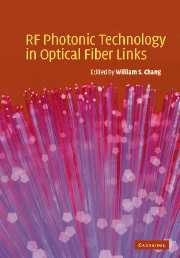Book contents
- Frontmatter
- Contents
- List of contributors
- Introduction and preface
- 1 Figures of merit and performance analysis of photonic microwave links
- 2 RF subcarrier links in local access networks
- 3 Analog modulation of semiconductor lasers
- 4 LiNbO3 external modulators and their use in high performance analog links
- 5 Broadband traveling wave modulators in LiNb03
- 6 Multiple quantum well electroabsorption modulators for RF photonic links
- 7 Polymer modulators for RF photonics
- 8 Photodiodes for high performance analog links
- 9 Opto-electronic oscillators
- 10 Photonic link techniques for microwave frequency conversion
- 11 Antenna-coupled millimeter-wave electro-optical modulators
- 12 System design and performance of wideband photonic phased array antennas
- Index
Introduction and preface
Published online by Cambridge University Press: 06 July 2010
- Frontmatter
- Contents
- List of contributors
- Introduction and preface
- 1 Figures of merit and performance analysis of photonic microwave links
- 2 RF subcarrier links in local access networks
- 3 Analog modulation of semiconductor lasers
- 4 LiNbO3 external modulators and their use in high performance analog links
- 5 Broadband traveling wave modulators in LiNb03
- 6 Multiple quantum well electroabsorption modulators for RF photonic links
- 7 Polymer modulators for RF photonics
- 8 Photodiodes for high performance analog links
- 9 Opto-electronic oscillators
- 10 Photonic link techniques for microwave frequency conversion
- 11 Antenna-coupled millimeter-wave electro-optical modulators
- 12 System design and performance of wideband photonic phased array antennas
- Index
Summary
RF technology is at the heart of our information and electronic technology. Traditionally, RF signals are transmitted and distributed electronically, via electrical cables and waveguides. Optical fiber systems have now replaced electrical systems in telecommunications. In telecommunication, RF signals are digitalized, the on/off digitally modulated optical carriers are then transmitted and distributed via optical fibers. However, RF signals often need to be transmitted, distributed and processed, directly, without going through the digital encoding process. RF photonic technology provides such an alternative. It will transmit and distribute RF signals (including microwave and millimeter wave signals) at low cost, over long distance and at low attenuation.
RF photonic links contain, typically, optical carriers modulated, in an analog manner, by RF subcarriers. After transmission and distribution, these modulated optical carriers are detected and demodulated at a receiver in order to recover the RF signals. The transmission characteristics of RF photonic links must compete directly with traditional electrical transmission and distribution systems. Therefore the performance of an RF photonic transmission or distribution system should be evaluated in terms of its efficiency, dynamic range and its signal-to-noise ratio.
RF photonic links are attractive in three types of applications. (1) In commercial communication applications, hybrid fiber coax (HFC) systems, including both the broadcast and switched networks, provide the low cost network for distribution of RF signals to and from users. RF photonic technology has already replaced cables in commercial applications such as CATV.
- Type
- Chapter
- Information
- RF Photonic Technology in Optical Fiber Links , pp. xv - xviiiPublisher: Cambridge University PressPrint publication year: 2002



